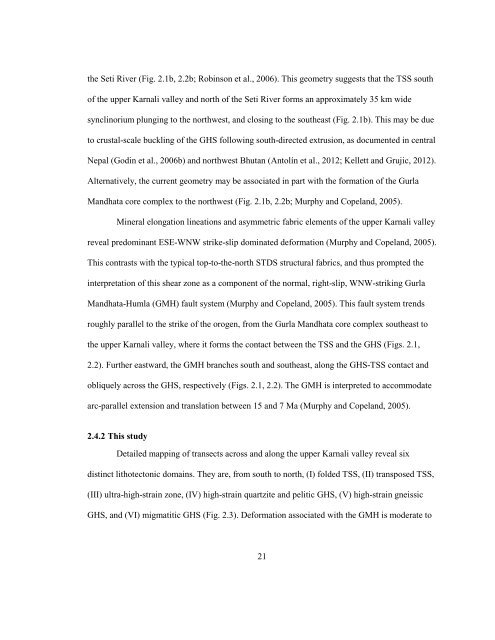title of the thesis - Department of Geology - Queen's University
title of the thesis - Department of Geology - Queen's University
title of the thesis - Department of Geology - Queen's University
Create successful ePaper yourself
Turn your PDF publications into a flip-book with our unique Google optimized e-Paper software.
<strong>the</strong> Seti River (Fig. 2.1b, 2.2b; Robinson et al., 2006). This geometry suggests that <strong>the</strong> TSS south<br />
<strong>of</strong> <strong>the</strong> upper Karnali valley and north <strong>of</strong> <strong>the</strong> Seti River forms an approximately 35 km wide<br />
synclinorium plunging to <strong>the</strong> northwest, and closing to <strong>the</strong> sou<strong>the</strong>ast (Fig. 2.1b). This may be due<br />
to crustal-scale buckling <strong>of</strong> <strong>the</strong> GHS following south-directed extrusion, as documented in central<br />
Nepal (Godin et al., 2006b) and northwest Bhutan (Antolín et al., 2012; Kellett and Grujic, 2012).<br />
Alternatively, <strong>the</strong> current geometry may be associated in part with <strong>the</strong> formation <strong>of</strong> <strong>the</strong> Gurla<br />
Mandhata core complex to <strong>the</strong> northwest (Fig. 2.1b, 2.2b; Murphy and Copeland, 2005).<br />
Mineral elongation lineations and asymmetric fabric elements <strong>of</strong> <strong>the</strong> upper Karnali valley<br />
reveal predominant ESE-WNW strike-slip dominated deformation (Murphy and Copeland, 2005).<br />
This contrasts with <strong>the</strong> typical top-to-<strong>the</strong>-north STDS structural fabrics, and thus prompted <strong>the</strong><br />
interpretation <strong>of</strong> this shear zone as a component <strong>of</strong> <strong>the</strong> normal, right-slip, WNW-striking Gurla<br />
Mandhata-Humla (GMH) fault system (Murphy and Copeland, 2005). This fault system trends<br />
roughly parallel to <strong>the</strong> strike <strong>of</strong> <strong>the</strong> orogen, from <strong>the</strong> Gurla Mandhata core complex sou<strong>the</strong>ast to<br />
<strong>the</strong> upper Karnali valley, where it forms <strong>the</strong> contact between <strong>the</strong> TSS and <strong>the</strong> GHS (Figs. 2.1,<br />
2.2). Fur<strong>the</strong>r eastward, <strong>the</strong> GMH branches south and sou<strong>the</strong>ast, along <strong>the</strong> GHS-TSS contact and<br />
obliquely across <strong>the</strong> GHS, respectively (Figs. 2.1, 2.2). The GMH is interpreted to accommodate<br />
arc-parallel extension and translation between 15 and 7 Ma (Murphy and Copeland, 2005).<br />
2.4.2 This study<br />
Detailed mapping <strong>of</strong> transects across and along <strong>the</strong> upper Karnali valley reveal six<br />
distinct lithotectonic domains. They are, from south to north, (I) folded TSS, (II) transposed TSS,<br />
(III) ultra-high-strain zone, (IV) high-strain quartzite and pelitic GHS, (V) high-strain gneissic<br />
GHS, and (VI) migmatitic GHS (Fig. 2.3). Deformation associated with <strong>the</strong> GMH is moderate to<br />
21

















